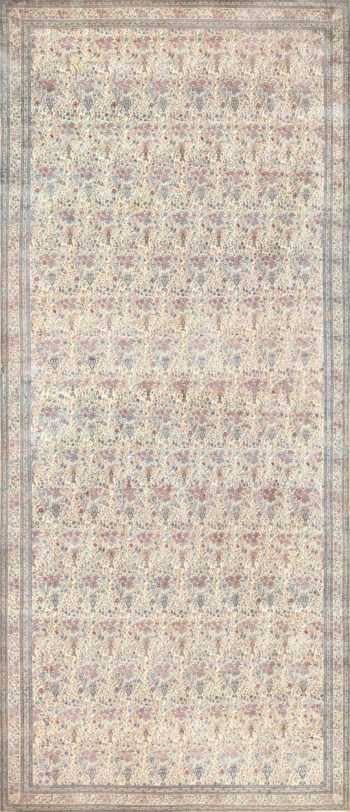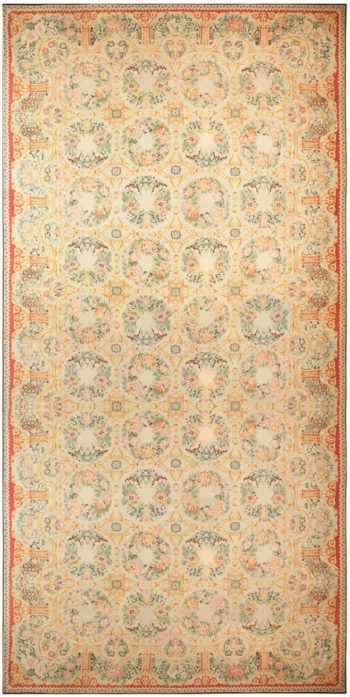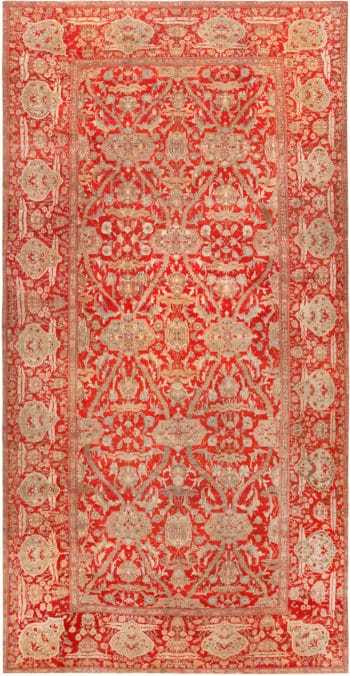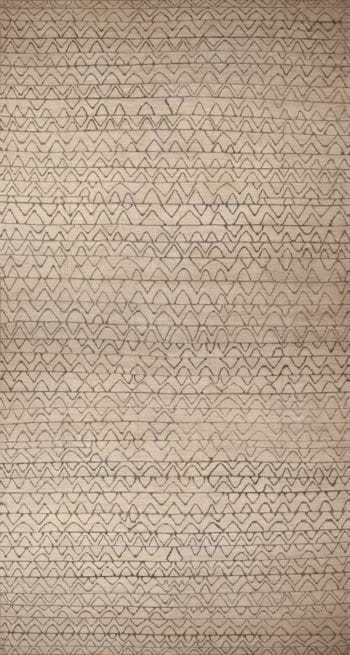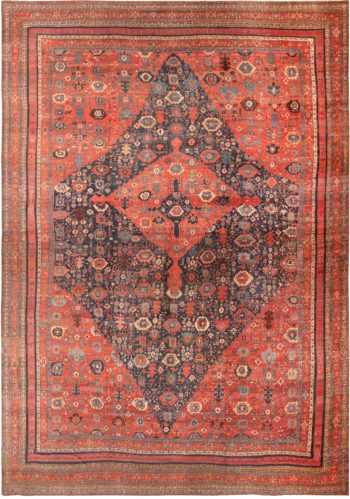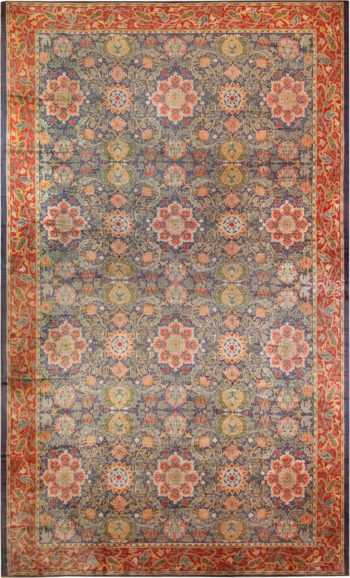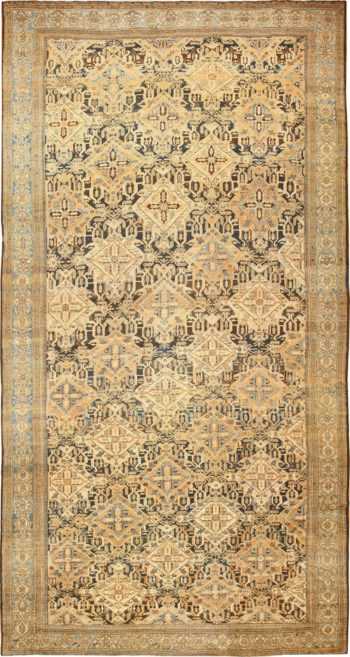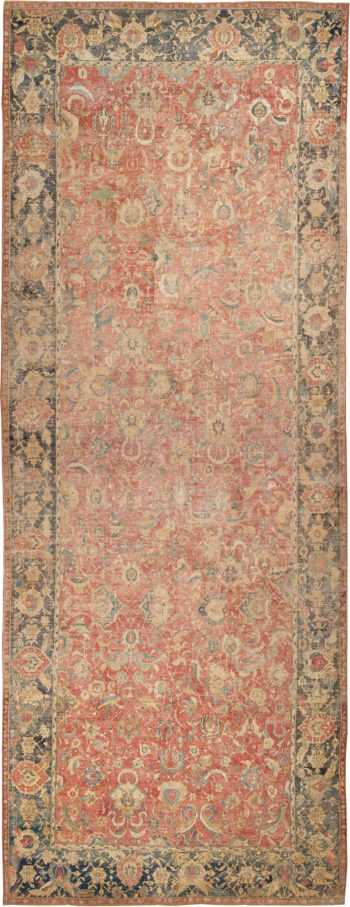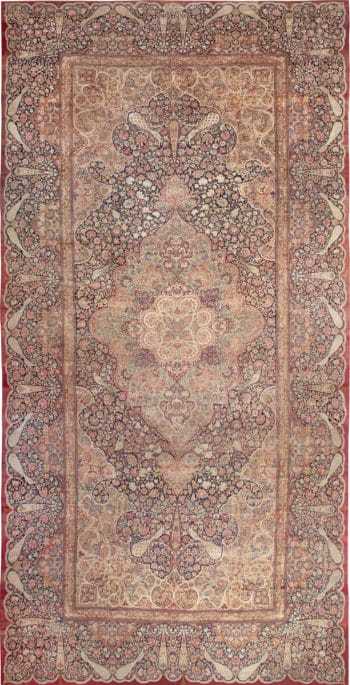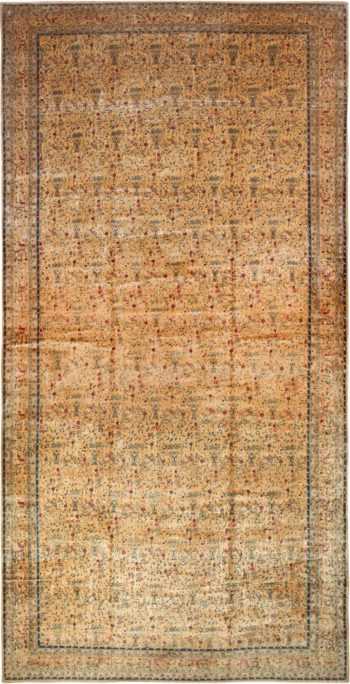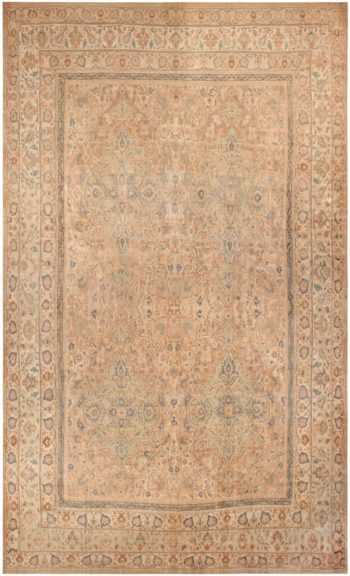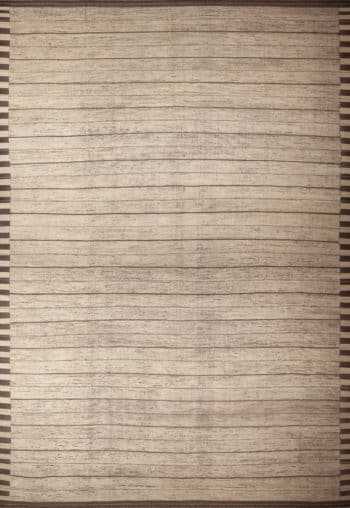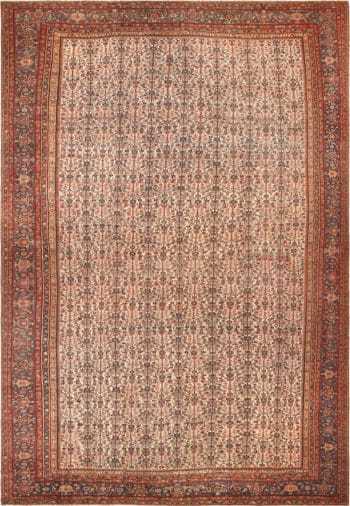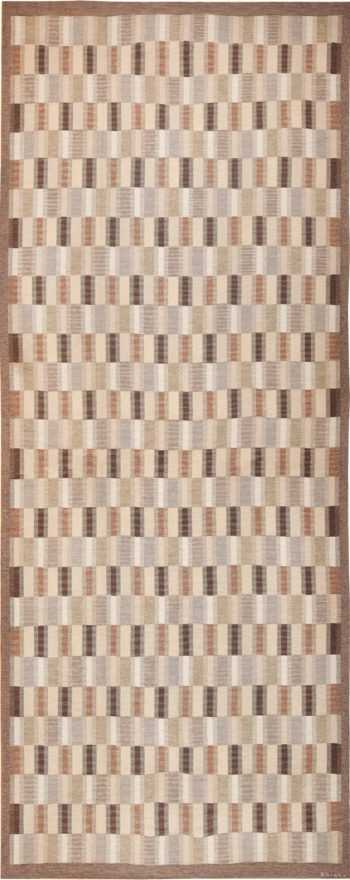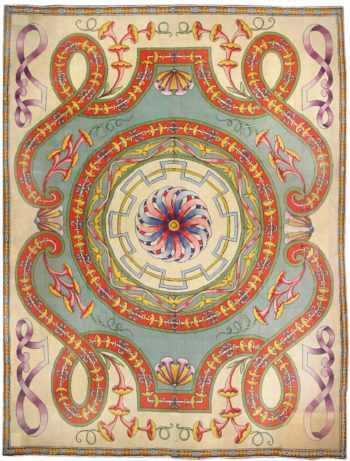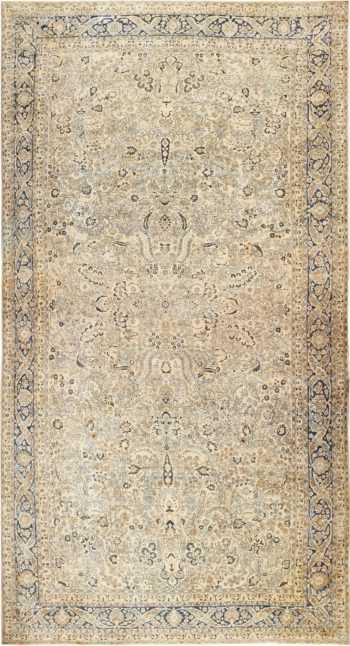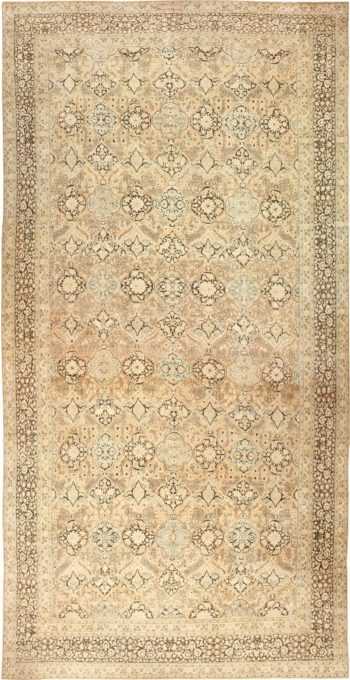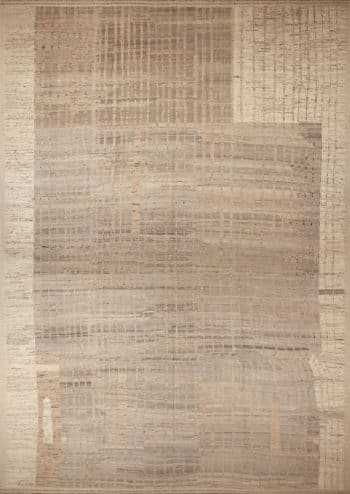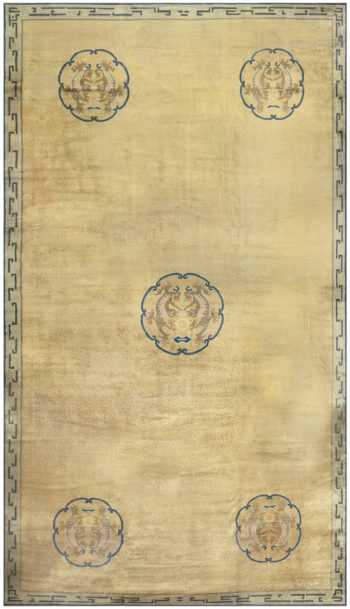Handmade Rugs
View our beautiful collection of handmade area rugs
-
Fine Ivory Floral Palace Oversized Antique Allover Oriental Persian Kerman Rug 48370
$140,000.00Size: 19 ft 7 in x 41 ft (5.97 m x 12.5 m) -
Antique Oversize Floral Romanian Bessarabian Kilim Rug 70101
$145,000.00Size: 17 ft 5 in x 34 ft (5.31 m x 10.36 m) -
Oversized Antique Persian Tabriz Haji Jalili Carpet 41353
Size: 21 ft 2 in x 32 ft 3 in (6.45 m x 9.83 m) -
Impressive Oversized Antique Persian Ziegler Sultanabad Rug 72255
$185,000.00Size: 16 ft 3 in x 32 ft (4.95 m x 9.75 m) -
Oversized Light Ivory Cream Tribal Chevron Modern Rug 11862
$33,740.00Size: 17 ft x 31 ft 5 in (5.18 m x 9.58 m) -
Durable Rustic Palace Size Antique Tribal Persian Bidjar Rug 71773
$145,000.00Size: 19 ft 5 in x 31 ft 3 in (5.92 m x 9.52 m) -
Rich Red Jewel Tone Oversized Antique Allover Design Indian Agra Rug 72240
$165,000.00Size: 18 ft 2 in x 30 ft 10 in (5.54 m x 9.4 m) -
Antique Oversized Arts and Crafts William Morris Rug 49912
$425,000.00Size: 19 ft x 30 ft (5.79 m x 9.14 m) -
Tribal Antique Oversized Persian Bakhtiari Geometric Rug 48042
$96,000.00Size: 15 ft x 30 ft (4.57 m x 9.14 m) -
Oversized Antique 17th Century Persian Esfahan Oriental Rug 44143
$285,000.00Size: 11 ft 4 in x 30 ft (3.45 m x 9.14 m) -
Fine Oversized Floral Animal Design Antique Persian Kerman Rug 72499
$88,000.00Size: 14 ft 3 in x 29 ft 8 in (4.34 m x 9.04 m) -
Fine Palace Oversized Decorative Allover Floral Vase Deign Antique Indian Rug 70305
$110,000.00Size: 16 ft x 29 ft 8 in (4.88 m x 9.04 m) -
Extra Large and Decorative Neutral Antique Indian Agra Carpet 50110
$96,000.00Size: 16 ft x 29 ft 6 in (4.88 m x 8.99 m) -
Beautiful Oversized Fine Decorative Antique Casual Elegant Persian Khorassan Rug 71956
$148,000.00Size: 18 ft 1 in x 29 ft 1 in (5.51 m x 8.86 m) -
Oversized Antique French Art Deco Carpet 70262
$95,000.00Size: 19 ft 4 in x 29 ft (5.89 m x 8.84 m) -
Oversized Neutral Cream Minimalist Geometric Stripe Modern Rug 11864
$35,595.00Size: 19 ft 7 in x 28 ft 10 in (5.97 m x 8.79 m) -
Ivory Background Allover Design Oversized Antique Persian Farahan Rug 72238
$45,000.00Size: 18 ft x 28 ft 10 in (5.49 m x 8.79 m) -
Vintage Oversize Scandinavian Brita Grahn Kilim Rug 49804
$66,000.00Size: 11 ft 8 in x 28 ft 10 in (3.56 m x 8.79 m) -
Beautiful Oversized Spanish Art Deco Design Carpet 50065
$220,000.00Size: 20 ft 4 in x 28 ft 2 in (6.2 m x 8.59 m) -
Decorative Antique Oversized Persian Khorassan Rug 48825
$89,000.00Size: 14 ft 4 in x 28 ft (4.37 m x 8.53 m) -
Large Oversize Antique Persian Khorassan Carpet 47032
$96,000.00Size: 12 ft x 28 ft (3.66 m x 8.53 m) -
Large Oversized Antique Decorative Brown Earth Tone Fine Floral Persian Khorassan Rug 48922
$88,000.00Size: 13 ft 4 in x 27 ft 4 in (4.06 m x 8.33 m) -
Oversized Light Neutral Earthy Tribal Geometric Nomadic Modern Rug 11856
$30,240.00Size: 17 ft 7 in x 27 ft 3 in (5.36 m x 8.31 m) -
Large Oversized Antique Dragon Chinese Carpet 50114
$69,000.00Size: 15 ft x 27 ft (4.57 m x 8.23 m)
Exploring the world of handmade area rugs
What is a handmade rug?
A handmade rug, also known as a handwoven rug or hand-knotted rug, is a type of rug that is crafted entirely by hand without the use of any automated machinery. Skilled artisans create these rugs using traditional weaving or knotting techniques, which have been passed down through generations and often vary based on the rug’s country of origin.
Key characteristics of handmade rugs include:
- Artisanal Craftsmanship: Handmade rugs are meticulously crafted by skilled artisans who devote significant time and effort to each piece. These artisans have honed their weaving or knotting skills over many years, ensuring that each rug is a unique and finely crafted work of art.
- Natural Materials: High-quality natural materials, such as wool, silk, cotton, and sometimes even natural fibers like jute or sisal, are commonly used to create handmade rugs. The use of natural materials contributes to the rugs’ durability, texture, and eco-friendliness.
- Traditional Techniques: Handmade rugs are created using traditional weaving or knotting techniques, which can vary depending on the rug’s country of origin. For example, Persian rugs are typically hand-knotted, while flat-woven rugs like Kilims are handwoven.
- Intricate Designs: Handmade rugs often feature intricate and elaborate designs, which can include geometric patterns, floral motifs, medallions, or pictorial elements. These designs are skillfully woven into the rug’s structure, giving the rug its unique visual appeal.
- Time-Intensive Process: Making a handmade rug is a labor-intensive process that can take several months or even years to complete, depending on the rug’s size, complexity, and the weaver’s skill level.
- Investment Value: Handmade rugs are at times considered valuable investments due to their craftsmanship, durability, and potential to appreciate in value over time. Fine handmade rugs can become family heirlooms and be passed down through generations.
Handmade rugs are treasured for their beauty, craftsmanship, and cultural significance. They are used as functional floor coverings in homes, but they also hold artistic and aesthetic value, making them sought-after pieces for interior decoration and collectors alike.
The dedication and skill of the artisans who create handmade rugs contribute to their timeless appeal and enduring popularity.
Are handmade rugs more expensive than machine made ones?
Yes, handmade rugs are generally more expensive compared to machine-made rugs.
Several factors contribute to the higher cost of handmade rugs:
- Labor-Intensive Process: Creating a handmade rug is a time-consuming and labor-intensive process that requires skilled artisans to invest significant effort and expertise. Each rug is crafted by hand, often taking several months to complete, depending on its size and complexity. The cost of skilled labor is a major factor in the higher price of handmade rugs.
- Artisanal Craftsmanship: Handmade rugs are often considered works of art due to their intricate designs and exceptional craftsmanship. The skill and creativity of the weavers play a significant role in the rug’s value, making it a premium product compared to mass-produced machine-made rugs.
- Quality and Durability: Handmade rugs are typically made from high-quality natural materials, such as wool or silk, which add to their durability and longevity. The use of natural fibers and traditional weaving techniques contributes to their higher cost compared to rugs made from synthetic materials using machine production.
- Uniqueness: Each handmade rug is a one-of-a-kind creation with unique designs and characteristics. Collectors and interior designers often seek out handmade rugs for their distinctiveness and individuality, which adds to their value.
- Cultural and Historical Significance: Handmade rugs often come from regions with rich weaving traditions and cultural significance. Antique or vintage handmade rugs, in particular, can hold historical value, further contributing to their higher price.
- Investment Value: Handmade rugs are sometimes seen as valuable investments, as their quality and uniqueness can appreciate in value over time. Fine handmade rugs, especially those from renowned weaving regions, can become sought-after collectibles, driving up their market price.
While handmade rugs do come with a higher price tag, they offer exceptional quality, craftsmanship, and aesthetic appeal, making them cherished possessions and centerpieces in interior design. The cost of a handmade rug can vary widely based on factors such as the material used, the intricacy of the design, the size, and the origin of the rug.
Are handmade rugs worth it?
The value of handmade rugs depends on various factors, and whether they are “worth it” is subjective and can vary based on personal preferences, budget, and specific needs.
Here are some considerations regarding handmade rugs:
- Quality and Craftsmanship: Handmade rugs are often valued for their high-quality craftsmanship. Skilled artisans typically spend a significant amount of time creating each rug, resulting in unique and durable pieces.
- Materials: Handmade rugs are often crafted from natural materials such as wool, silk, or cotton, which can contribute to their durability and aesthetic appeal. The choice of materials can affect the rug’s texture, feel, and overall quality.
- Artistic Value: Many handmade rugs are considered works of art, especially those from traditional rug-making regions with a rich history of weaving. The intricate patterns, designs, and color combinations can add artistic value to a space.
- Longevity: Well-made handmade rugs can last for generations with proper care. This longevity can make them a good investment compared to machine-made rugs, which may not have the same durability.
- Unique Designs: Handmade rugs often feature unique designs and patterns that may not be replicated in mass-produced rugs. This uniqueness can be appealing for individuals seeking one-of-a-kind pieces for their homes.
- Ethical Considerations: Some people appreciate the ethical aspect of supporting traditional craftsmanship and local artisans. Purchasing handmade rugs can contribute to the preservation of cultural heritage and sustainable practices.
- Cost: Handmade rugs are typically more expensive than machine-made alternatives. The cost is influenced by factors such as the complexity of the design, the quality of materials, and the time invested in crafting the rug. Whether the cost is justified depends on individual preferences and budget constraints.
It’s important to note that personal preferences and priorities play a significant role in determining whether handmade rugs are worth the investment. Some individuals may prioritize the artistic and cultural aspects, while others may focus on practical considerations such as cost and ease of maintenance.
Ultimately, the decision to invest in a handmade rug should align with your specific needs and preferences.
Can you vacuum a handmade rug?
Yes, you can vacuum a handmade rug, but there are some considerations and precautions.
Here are some things to keep in mind to ensure that you don’t damage the handmade rug:
- Gentle Vacuuming: Use a vacuum cleaner with adjustable suction and beater bar settings. If possible, set the vacuum to a lower suction level to avoid pulling or damaging the fibers of the rug. Turn off the beater bar or use it on the lowest setting to prevent excessive agitation.
- Frequency: While regular vacuuming is generally good for maintaining the cleanliness of rugs, the frequency may vary based on the rug’s location and foot traffic. High-traffic areas may require more frequent vacuuming.
- Rotate the Rug: To ensure even wear and tear, rotate the handmade rug periodically. This helps distribute foot traffic and sunlight exposure more evenly, preventing specific areas from becoming more worn or faded than others.
- Use a Rug Pad: Placing a rug pad underneath the handmade rug provides additional protection. A rug pad can prevent the rug from slipping, reduce friction between the rug and the floor, and provide some cushioning.
- Avoid Fringe Damage: Be cautious around the fringe or edges of the rug, as they are more susceptible to damage. Do not vacuum over the fringe, and if the rug has long fringes, it’s often recommended to lift them out of the way before vacuuming.
- Check for Loose Threads: Before vacuuming, inspect the rug for any loose threads or damaged areas. Vacuuming over loose threads can pull them out and cause further damage.
- Professional Cleaning: Consider professional cleaning for your handmade rug periodically, especially if it’s heavily soiled or stained. Professional cleaners have the expertise to clean and care for delicate handmade rugs without causing harm.
Remember that handmade rugs, especially those made from natural fibers like wool or silk, may be more delicate than machine-made counterparts. It’s essential to treat them with care to preserve their beauty and longevity. If you have any specific care instructions from the rug manufacturer or seller, be sure to follow them to maintain the rug’s quality.
What makes handmade rugs so special?
Handmade rugs are considered special and valued for several reasons, ranging from the craftsmanship involved in their creation to their unique qualities.
Here are some factors that contribute to the special nature of handmade rugs:
- Artisan Craftsmanship: Handmade rugs are crafted by skilled artisans who use traditional techniques passed down through generations. The time, effort, and expertise invested in creating each rug contribute to its unique and often intricate design.
- Individuality and Uniqueness: Unlike mass-produced rugs, handmade rugs are often one-of-a-kind pieces. Artisans may infuse their creativity into the design, resulting in unique patterns, color combinations, and textures that are not replicated in other rugs.
- Quality Materials: Handmade rugs are typically crafted from high-quality, natural materials such as wool, silk, or cotton. The choice of materials contributes to the rug’s durability, texture, and overall aesthetic appeal.
- Cultural and Historical Significance: Rugs from specific regions often carry cultural and historical significance. They may showcase traditional motifs, patterns, and weaving techniques that are deeply rooted in the heritage of the artisan’s community.
- Longevity and Durability: Well-made handmade rugs are known for their durability and longevity. With proper care, these rugs can last for generations, becoming heirloom pieces passed down through families.
- Ethical Considerations: Some people appreciate the ethical aspect of supporting traditional craftsmanship and local artisans. Purchasing handmade rugs can contribute to the preservation of cultural heritage, support sustainable practices, and provide income to skilled craftspeople.
- Artistic Value: Handmade rugs are often considered works of art. The craftsmanship, attention to detail, and artistic expression involved in their creation elevate them beyond functional floor coverings, making them a focal point in interior design.
- Customization and Personalization: In some cases, individuals can commission handmade rugs with specific designs, colors, and sizes to suit their personal preferences and the aesthetic of their living spaces.
- Connection to Nature: Natural materials used in handmade rugs, such as wool, provide a connection to the environment. These materials are renewable and biodegradable, making them environmentally friendly choices.
- Story and Tradition: Each handmade rug carries a story. It reflects the cultural traditions, artistic influences, and personal experiences of the artisans who created it. Knowing the story behind a handmade rug can add depth and meaning to its presence in a home.
While handmade rugs may come at a higher cost compared to machine-made alternatives, many people find their special qualities and the cultural, artistic, and ethical aspects associated with them make the investment worthwhile.
Learn More About Antique Handmade Rugs and Carpets
Handmade rugs have a certain quality that sets them far above machine-made examples, irrespective of any sort of superficial similarities in design. Traditionally, the process of producing a product by hand – especially a product as complex as an Oriental carpet – is more costly than the process of producing a product by machine.
As such, the decision to make something by hand and, subsequently, to incur greater costs, must necessarily result in a superior product. This is why the buyer for handwoven rugs and carpets will have a certain set of expectations when it comes to the care that went into weaving them as well as the overall quality.
The weaving of area rugs by hand involves so many different choices and decisions with some that are made on the fly. Minor changes, twists and turns will, when viewing the final product, give the area rug its own unique personality and presence. This is something that even finest of all the machine made area rugs simply cannot equal. For those who can distinguish such qualities, only hand made carpets will do, and that involves a certain minimal cost level. Handmade rugs, even a small one, can take many months to produce. A room-size carpet may take the same time, but only because it is produced by multiple weavers working in concert.

Moroccan Rug Weavers Handmaking Rugs
Because the process of weaving something as complex as an antique Oriental carpet demands so much, the resulting products are always one of a kind. Similarly, their quality and longevity is insured by the high level of care and consideration that is woven into them by the master artisans responsible for their creation. Unique works of art that are in a totally separate category from mass-produced, machine-made carpets, hand-made rugs and carpets possess qualities and characteristics that simply cannot be imitated.
The Beauty of Antique Handmade Rugs
Thousands of years after carpet weaving was perfected, handmade rugs are still the gold standard. In the world of fine carpets, there is no better way to produce exquisite woven designs and strong, tightly packed pile than by using simple tools and the skills of trained weavers and master craftspeople. These historic traditions and age-old weaving techniques are still carried on by modern rug producers and highly skilled artisans.
In the world of fine handmade rugs, there are innumerable styles and variations. Kilims, flat-weave Moroccan rugs and Scandinavian rugs (matta rolakan) employ similar warp and weft construction techniques although their design repertoires are quite distinctive.
Handmade rugs with their hand-knotted pile are revered for their intricate patterns, superb texture and durability. Long-pile Moroccans and shaggy vintage Swedish Rya rugs have long uncut yarns that produce a marvelous effect, which cannot be replicated by tufting or any modern technique. Handmade rugs are part of an enduring tradition that has never been surpassed by technology or machines.
Handmade Rugs are Woven for Comfort and Appearance
Handmade rugs are relatively complex, multifaceted works of art. As such, there are a great number of factors to consider when evaluating such pieces for your own purchase, and, sometimes, the process of choosing a rug for yourself may seem a bit daunting. But don’t worry – you’ve certainly come to the right place for help!
While rugs and carpets appeal most immediately to us on a visual level, possessing gorgeous, intricate designs, comprised of masterful line work and brilliant color application like geometric, it is important to remember that such pieces are also tactile, three dimensional objects that exist to serve a utilitarian function – as cushioning and insulation. One style that stands out in geometric patters are Kilim Flat-weave rugs, which utilize a wide range of neutral earthy colors to form basic shapes, pleasing to the eye and still strong in design.
It is important for potential buyers to consider the extent to which this particular aspect of the rug will matter to them, and whether it will ultimately influence the decision of which rug is chosen.
If you as a buyer determine that in fact you need some heft to your traditional rugs, then higher pile village or tribal weaving like Vintage Moroccans will be more appropriate than many other types of area rugs for your needs.
Read about our pile and knotted rugs.
In fact, many other types of rugs are deliberately made with a lower pile to emphasize the precision of the drawing in the design, notably in traditional Oushak rugs. Various new rug productions are also made in a thicker pile with a notable cushioning effect.
However, traditional Handmade rugs may be less appropriate for those who desire high, cushy pile, since even if in good condition, they tend to have a lower pile due to wear. Above all things, when you embark on the quest of choosing a rug for your home, the most important thing to remember is that the rug that ultimately choose should be one that makes you happy.
Are handmade area rugs better than machine made rugs?
Whether handmade area rugs are better than machine-made rugs depends on various factors and personal preferences. Both types of rugs have their own advantages and disadvantages, and the “better” option will vary depending on your specific needs and priorities.
Here’s a comparison between machine made and handmade rugs:
About Handmade Area Rugs:
- Quality and Craftsmanship: Handmade rugs are often considered to have superior quality and craftsmanship. Skilled artisans create these rugs using traditional techniques that have been passed down through generations. This can result in intricate designs, fine detailing, and a sense of uniqueness.
- Unique and Artistic: Handmade rugs are one-of-a-kind pieces of art. The variations in colors, patterns, and textures make them stand out and add a touch of individuality to your space.
- Durability: Handmade rugs can be more durable and have a longer lifespan compared to some machine-made rugs. The attention to detail and the use of high-quality materials contribute to their resilience.
- Investment Value: Handmade rugs, especially those made by renowned artisans or in certain regions with a rich rug-making history, can appreciate in value over time, making them potential long-term investments.
- Environmental Impact: Handmade rugs often have a smaller environmental footprint compared to mass-produced machine-made rugs, as they typically use natural materials and traditional techniques.
About Machine-Made Rugs:
- Affordability: Machine-made rugs are generally more affordable than handmade rugs. They are produced in bulk using automated processes, which can result in lower costs.
- Consistency: Machine-made rugs offer a high level of consistency in terms of design, pattern, and color. If you’re looking for a uniform look across multiple rugs, machine-made options might be preferable.
- Availability: Machine-made rugs are widely available and come in a variety of styles, sizes, and designs. You’re more likely to find a machine-made rug that fits your specific requirements.
- Maintenance: Machine-made rugs can sometimes be easier to clean and maintain due to their construction and materials.
- Practicality: If you’re looking for a rug that will be placed in a high-traffic area or an environment where the rug is likely to experience heavy use, a machine-made rug might be a more practical choice.
Ultimately, the decision between machine-made and handmade area rugs depends on your budget, aesthetic preferences, and intended use.
Handmade rugs offer a sense of artistry, history, and individuality, while machine-made rugs provide affordability, consistency, and practicality. It’s important to carefully consider your priorities and do thorough research before making a decision.

